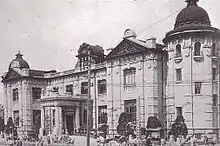Bank of Korea (1909–1950)
The Bank of Joseon (Korean: 조선은행) or Bank of Chosen (Japanese: 朝鮮銀行) was the central bank of Colonial Korea, and of South Korea. The bank issued the Korean yen from 1910 to 1945 and the won from 1945 to 1950.
| Bank of Joseon | |||||||
 Head office in Seoul | |||||||
| Japanese name | |||||||
|---|---|---|---|---|---|---|---|
| Kanji | 朝鮮銀行 | ||||||
| |||||||
| Korean name | |||||||
| Hangul | |||||||
| Hanja | |||||||
| |||||||
History and background
The bank was established by the Governor-General of Korea in 1910 as the Kankoku Ginkō, taking the place of the privately held Korean branch of Daiichi Kokuritsu Ginkō (First National Bank), which had established a branch in 1878. The Bank of Korea assumed responsibility for the banknotes issued by the Dai-Ichi Bank that were still in circulation (which totalled 12,000,000 yen), the Dai-Ichi Bank would further transfer to the Bank of Korea the 4,000,000 yen in specie reserves which backed its banknotes. The balance was converted by the Bank of Korea to a loan of 20 years without interest to the Dai-Ichi Bank.[1]
After the annexation of Korean Empire by Japan in 1910, the bank was reorganized and its name was changed to reflect the official name for Korea.
The bank remained a privately held corporation with stock owned by a number of Japanese banks and companies; however, its board was appointed by the Governor-General of Korea.
The bank was responsible for issuing currency in Korea, regulated domestic prices, and serviced international trade with branches in Manchukuo, and major ports in China and in Japan, as well as in London and New York City.
The bank was dissolved in 1950 and replaced by the newly formed Bank of Korea.
See also
- Korean Yen
References
- Joseph E. Boling, NLG (1988). "Korea - A Numismatic Survey. (This article has been transposed to this format from a July 1988 supplement issue included with Coin World. Its original title was: Beyond Cash - A Numismatic Survey of Korea.)" (PDF). Moneta-Coins.com. Retrieved 3 October 2019.